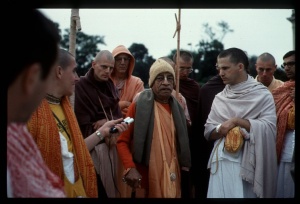CC Madhya 6.101: Difference between revisions
m (1 revision(s)) |
No edit summary |
||
| Line 1: | Line 1: | ||
{{ | [[Category:Sri Caitanya-caritamrta - Madhya-lila Chapter 06|C101]] | ||
<div style="float:left">'''[[Sri Caitanya-caritamrta|Śrī Caitanya-caritāmṛta]] - [[CC Madhya|Madhya-līlā]] - [[CC Madhya 6|Chapter 6: The Liberation of Sārvabhauma Bhaṭṭācārya]]'''</div> | |||
<div style="float:right">[[File:Go-previous.png|link=CC Madhya 6.100|Madhya-līlā 6.100]] '''[[CC Madhya 6.100|Madhya-līlā 6.100]] - [[CC Madhya 6.102|Madhya-līlā 6.102]]''' [[File:Go-next.png|link=CC Madhya 6.102|Madhya-līlā 6.102]]</div> | |||
{{CompareVersions|CC|Madhya 6.101|CC 1975|CC 1996}} | |||
{{RandomImage}} | |||
==== TEXT 101 ==== | ==== TEXT 101 ==== | ||
<div | <div class="verse"> | ||
āsan varṇās trayo hy asya | :āsan varṇās trayo hy asya | ||
gṛhṇato ’nu-yugaṁ tanūḥ | :gṛhṇato ’nu-yugaṁ tanūḥ | ||
śuklo raktas tathā pīta | :śuklo raktas tathā pīta | ||
idānīṁ kṛṣṇatāṁ gataḥ | :idānīṁ kṛṣṇatāṁ gataḥ | ||
</div> | </div> | ||
| Line 14: | Line 18: | ||
==== SYNONYMS ==== | ==== SYNONYMS ==== | ||
<div | <div class="synonyms"> | ||
''āsan''—there were; ''varṇāḥ''—colors; ''trayaḥ''—three; ''hi''—indeed; ''asya''—of Him; ''gṛhṇataḥ''—accepting; ''anu-yugam''—according to the age; ''tanūḥ''—bodies; ''śuklaḥ''—white; ''raktaḥ''—red; ''tathā''—also; ''pītaḥ''—yellow; ''idānīm''—at the present moment; ''kṛṣṇatām''—blackish; ''gataḥ''—has accepted. | |||
</div> | </div> | ||
| Line 21: | Line 25: | ||
==== TRANSLATION ==== | ==== TRANSLATION ==== | ||
<div | <div class="translation"> | ||
“‘In the past, your son has had bodies of three different colors, according to the age. These colors were white, red and yellow. In this age [Dvāpara-yuga] He has accepted a blackish body.’ | “‘In the past, your son has had bodies of three different colors, according to the age. These colors were white, red and yellow. In this age [Dvāpara-yuga] He has accepted a blackish body.’ | ||
</div> | </div> | ||
| Line 28: | Line 32: | ||
==== PURPORT ==== | ==== PURPORT ==== | ||
<div | <div class="purport"> | ||
This verse from Śrīmad-Bhāgavatam ([[SB 10.8.13]]) was spoken by Garga Muni when he was performing the rituals at Lord Kṛṣṇa’s name-giving ceremony. He states that the incarnations of the Lord in other ages had been white, red and yellow. This yellow color refers to Śrī Caitanya Mahāprabhu, whose bodily complexion was yellowish. This confirms that in past Kali-yugas the Lord also had incarnated in a body that was yellow in hue. It is understood that the Lord incarnates in different colors for the different yugas (Satya, Tretā, Dvāpara and Kali). Accepting the color yellow (pīta), as well as other characteristics, the Lord incarnated as Śrī Caitanya Mahāprabhu. This is the verdict of all Vedic authorities. | This verse from [[Srimad-Bhagavatam|''Śrīmad-Bhāgavatam'']] ([[SB 10.8.13]]) was spoken by Garga Muni when he was performing the rituals at Lord Kṛṣṇa’s name-giving ceremony. He states that the incarnations of the Lord in other ages had been white, red and yellow. This yellow color refers to Śrī Caitanya Mahāprabhu, whose bodily complexion was yellowish. This confirms that in past Kali-yugas the Lord also had incarnated in a body that was yellow in hue. It is understood that the Lord incarnates in different colors for the different ''yugas'' (Satya, Tretā, Dvāpara and Kali). Accepting the color yellow (''pīta''), as well as other characteristics, the Lord incarnated as Śrī Caitanya Mahāprabhu. This is the verdict of all Vedic authorities. | ||
</div> | </div> | ||
__NOTOC__ | |||
<div style="float:right; clear:both;">[[File:Go-previous.png|link=CC Madhya 6.100|Madhya-līlā 6.100]] '''[[CC Madhya 6.100|Madhya-līlā 6.100]] - [[CC Madhya 6.102|Madhya-līlā 6.102]]''' [[File:Go-next.png|link=CC Madhya 6.102|Madhya-līlā 6.102]]</div> | |||
__NOTOC__ | |||
__NOEDITSECTION__ | |||
Revision as of 05:17, 29 July 2021

A.C. Bhaktivedanta Swami Prabhupada
TEXT 101
- āsan varṇās trayo hy asya
- gṛhṇato ’nu-yugaṁ tanūḥ
- śuklo raktas tathā pīta
- idānīṁ kṛṣṇatāṁ gataḥ
SYNONYMS
āsan—there were; varṇāḥ—colors; trayaḥ—three; hi—indeed; asya—of Him; gṛhṇataḥ—accepting; anu-yugam—according to the age; tanūḥ—bodies; śuklaḥ—white; raktaḥ—red; tathā—also; pītaḥ—yellow; idānīm—at the present moment; kṛṣṇatām—blackish; gataḥ—has accepted.
TRANSLATION
“‘In the past, your son has had bodies of three different colors, according to the age. These colors were white, red and yellow. In this age [Dvāpara-yuga] He has accepted a blackish body.’
PURPORT
This verse from Śrīmad-Bhāgavatam (SB 10.8.13) was spoken by Garga Muni when he was performing the rituals at Lord Kṛṣṇa’s name-giving ceremony. He states that the incarnations of the Lord in other ages had been white, red and yellow. This yellow color refers to Śrī Caitanya Mahāprabhu, whose bodily complexion was yellowish. This confirms that in past Kali-yugas the Lord also had incarnated in a body that was yellow in hue. It is understood that the Lord incarnates in different colors for the different yugas (Satya, Tretā, Dvāpara and Kali). Accepting the color yellow (pīta), as well as other characteristics, the Lord incarnated as Śrī Caitanya Mahāprabhu. This is the verdict of all Vedic authorities.